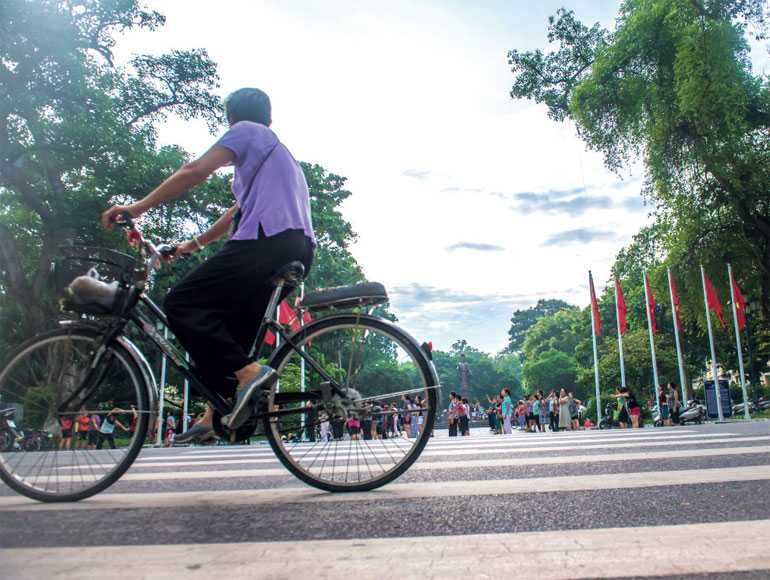Tuesday Jan 07, 2025
Tuesday Jan 07, 2025
Thursday, 26 March 2020 00:00 - - {{hitsCtrl.values.hits}}

Healthy lifestyles and livable cities are an important part of warding off the next pandemic. Photo by ADB
By Susann Roth and Najibullah Habib
blogs.adb.org: The COVID-19 pandemic could be an opportunity to take a more holistic approach to health and well-being, invest in health systems and in resilient supply chains.
Viruses that cause new diseases like COVID-19 are unpredictable. Their impact depends partly on population dynamics, partly on demographics and behaviour, and of course on the nature of the virus itself. We don’t know the virus well enough to know what it will do next, or to say with certainty how we can best protect high-risk groups.
What we do know is that bold actions are needed to contain and defeat this and future pandemics. Dealing with risk factors driving infections requires strong leadership, quick decisions based on scientific evidence, and the full cooperation of national and local governments, as well as people.
Based on our experience, the impacts of national responses to epidemics are often short-lived. Over time, the crisis fades and we forget what it takes to establish fast emergency response capacity, strengthen health systems and ensure population health for the long-term.
This needs to change, particularly in Asia and the Pacific which faces a confluence of risk factors including environmental degradation, climate change, air pollution, cross-border threats, urbanisation, population density, global air travel, and trade.
Long-term solutions will only emerge if we expand our understanding of infectious disease risks. So let’s look at three important risk factors that drive infections.
The first and most important is a person’s overall health. How strong is one’s immune system? It is the first line of defense against infectious agents. In cities across the region, air pollution takes a toll on our respiratory system’s ability to respond effectively to infectious agents.
Unhealthy living conditions, stress and sleep deprivation weaken people’s immune systems and well-being. In addition, rising levels of non-communicable diseases caused by bad diet and unhealthy habits such as smoking and excessive alcohol consumption contribute to poor health, making the population even more vulnerable to infectious diseases like COVID-19.
Second, the likelihood that people will infect each other. This is driven by the virulence of the contagion but also more importantly by behaviour. In this region, we often have densely populated urban areas which bring together many people who can infect each other. Trying to manage human interaction leads to social distancing, banning of air travel, closing of borders.
Will these drastic measures be worthwhile considering the harm they can bring, especially on the poor? Will more people suffer from bankruptcy rather than from illness as a result of the containment measures? We don’t know yet.
Third, infections can multiply in health care facilities without interventions such as infection prevention and control through personal protective equipment, isolation, decentralised COVID-19 testing and proper triaging of patients.
Many hospitals particularly in developing Asia do not follow international best practices in this regard, and global supplies of personal protective equipment are overstretched. Hence, the people you need most in a pandemic – doctors, nurses and health care workers – will fall ill first. This puts already weak health systems at risk of collapsing and failing to provide essential services.
Countries in Asia have valuable lessons to share. These include expanded testing of the population for COVID-19 at no cost in order to help authorities track the progress of the disease and determine whether health interventions are working.
Travel restrictions and strict quarantines, applied rigorously, have been proven to slow the disease and flatten the curve to prevent health services from being overburdened.
Some Asian countries have independently-managed public health bodies that report directly to the top leadership of the country to ensure quick action and reduce red tape. Emergency procurement mechanisms and market protection to allow the fast purchase of goods and even advanced market commitments for vaccines are other important tools. Transparent communication of risks and frequent updates to the public bolster people’s confidence in the government’s response.
These are important responses, but in the long run we need deeper policy shifts to ward off future outbreaks. We can start with these:
Get back to basics. Take a holistic view of population health and not just medical care. We need clean air in our cities, the promotion of healthy lifestyles, the reduction of harmful food choices and policies that foster wellbeing to prevent people from falling ill in the first place. We need to invest in high quality health care which focuses on health promotion and disease prevention, as well as decentralised and cost-effective primary health care.
Manage the confluence of risks. Risks are multiplying as our world is increasingly interconnected through travel, trade and tourism. Evidence-based management of epidemics using scenario planning and risk assessments can help. The economic impact hits the most vulnerable: daily-wage workers, factory workers, small business owners, gig economy workers, and the self-employed. Coordinated approaches by multiple actors such as the government, private sector and civil society, can help manage the multitude of risks.
The COVID-19 pandemic is an unfolding global crisis. But it is also an opportunity to take a more holistic approach to health and well-being, invest in health systems and in resilient supply chains for the long-term benefit of all.
(Susann Roth is the Principal Knowledge Sharing and Services Specialist, Sustainable Development and Climate Change Department and Najibullah Habib is the Health Specialist, East Asia Regional Department, ADB)
(Source: https://blogs.adb.org/blog/lets-take-bold-action-health-avoid-future-pandemics)